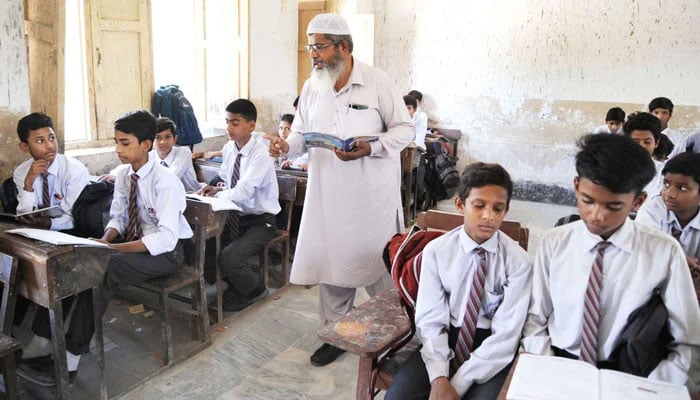Rajanpur schools still need repair, restoration after flood havoc
MULTAN: The school education infrastructure in flood-affected areas of Rajanpur district is yet to be fully restored. The South Punjab School Education Department has been conducting analyses and assessments of the damaged schools for over a year after the floods. Civil society activists and parents from these areas have raised concerns, urging the government to prioritize the proper restoration of school infrastructure.
Academic activities in the flood-hit districts are almost suspended due to the extensive destruction caused by the flood. The South Punjab School Education officials said the flood brought havoc in the Dera Ghazi Khan division. The flood damaged school buildings in parts of Jampur, DG Khan, Rajanpur, Taunsa, Fazalpur and adjoining localities. There are many schools where floodwater inundated four walls.
The officials then estimated damage to over 200 primary, secondary and higher secondary schools of boys and girls had been destroyed or damaged. The United Nations International Children’s Emergency Fund was the only organization that stood with students in destroyed areas and its work is visible on the ground to restore schools infrastructure following the massive floods that hit Pakistan engulfing nearly 90 percent of the area in the Rajanpur district of South Punjab, damaging the infrastructure and livelihood severely.
A total of 540 schools were damaged only in Rajanpur district due to floods. UNICEF has so far provided High-Performance Tents (HPTs) to the damaged schools so that children can continue their education till their schools are renovated and functional. These HPTs are making a huge difference in the lives of children who can continue to learn in a conducive environment.
The flood disaster disrupted household and community protection mechanisms and put children at risk of various forms of abuse, neglect, and exploitation. The South Punjab education officials observed that the flood had damaged school buildings in parts of Jampur, DG Khan, Rajanpur, Taunsa, Fazalpur and adjoining localities. It was estimated that the flood had damaged over 200 primary, secondary and higher secondary schools of boys and girls in the division.
The South Punjab School Education Department is still working on school damage after two years of flood. The poor situation was revealed at a meeting held to review the pace of restoration of schools in Rajanpur flood-hit areas.
Speaking at the meeting the South Punjab Secretary School Dr Obaidullah Khokhar said that “effective measures” should be taken through a better strategy to restore the infrastructure of the schools affected by the last flood in the districts of Rajanpur and Dera Ghazi Khan.
He said that due to the worst floods in history and the dangerous and destructive monsoon rains last year, the infrastructure of the schools of Dera Ghazi Khan and Rajanpur was destroyed, while many schools were destroyed.
During the meeting attended by officials and social organizations, South Punjab Additional Secretary Khawaja Mazharul Haque emphasized the importance of advance measures to prevent natural calamities due to increasing natural disasters caused by climate change.
-
 Prince Harry On Moment Meghan Markle Made Him Feel Like A ‘teenager’
Prince Harry On Moment Meghan Markle Made Him Feel Like A ‘teenager’ -
 Zayn Malik Debuts Four Unreleased Songs At Vegas Residency Premiere
Zayn Malik Debuts Four Unreleased Songs At Vegas Residency Premiere -
 Katy Perry 'wants' Justin Trudeau’s Baby
Katy Perry 'wants' Justin Trudeau’s Baby -
 Prince William, Kate Middleton’s Frustrations Rise As Divorce Rumors Finally Get Answered?
Prince William, Kate Middleton’s Frustrations Rise As Divorce Rumors Finally Get Answered? -
 Charlie Puth Gets Real About Super Bowl Anthem Role
Charlie Puth Gets Real About Super Bowl Anthem Role -
 Kim Kardashian Explains Why She Rarely Sees Jonathan Cheban Now
Kim Kardashian Explains Why She Rarely Sees Jonathan Cheban Now -
 Meghan Markle Spilt ‘third Date’ Magic With Prince Harry
Meghan Markle Spilt ‘third Date’ Magic With Prince Harry -
 When Will 'Jujutsu Kaisen' Season 3 Ep 4 Come Out?
When Will 'Jujutsu Kaisen' Season 3 Ep 4 Come Out? -
 Prince William Lays Down The Law As Andrew’s Exile Nears: ‘Even If He Spirals Out Of Control’
Prince William Lays Down The Law As Andrew’s Exile Nears: ‘Even If He Spirals Out Of Control’ -
 Phil Collins Shares New Details About His Long-running Health Struggles
Phil Collins Shares New Details About His Long-running Health Struggles -
 Paris Hilton Reveals Sweet Sibling Dynamic Between Phoenix, London
Paris Hilton Reveals Sweet Sibling Dynamic Between Phoenix, London -
 Chris Pratt Gets Honest About Panic Around AI
Chris Pratt Gets Honest About Panic Around AI -
 Jennifer Garner Shares Rare Parenting Insight After Ex Ben Affleck's Remark: 'I've Been There'
Jennifer Garner Shares Rare Parenting Insight After Ex Ben Affleck's Remark: 'I've Been There' -
 King Charles Exits London Without Seeing Prince Harry
King Charles Exits London Without Seeing Prince Harry -
 Kim Kardashian Praises Taylor Swift Despite Past Feud: 'Great Artist'
Kim Kardashian Praises Taylor Swift Despite Past Feud: 'Great Artist' -
 Stefon Diggs Pays Tribute To Cardi B: ‘I Don’t Talk Too Much But’
Stefon Diggs Pays Tribute To Cardi B: ‘I Don’t Talk Too Much But’




